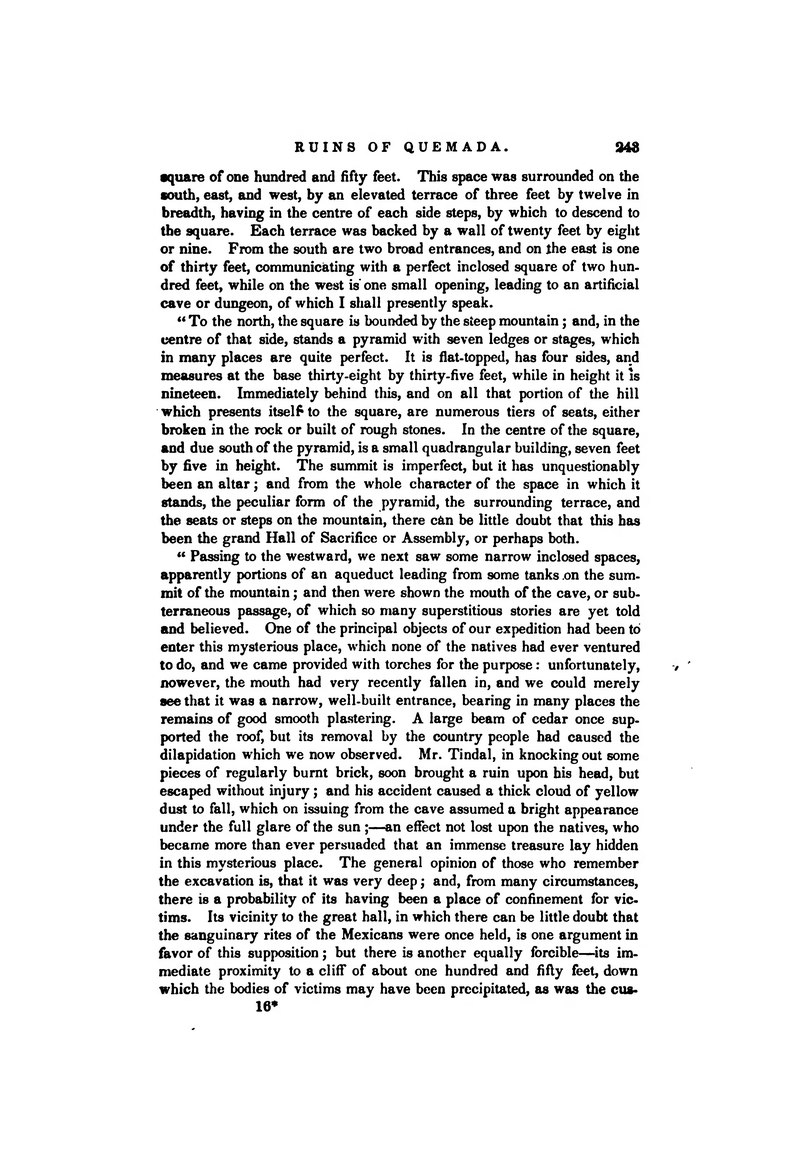square of one hundred and fifty feet. This space was surrounded on the south, east, and west, by an elevated terrace of three feet by twelve in breadth, having in the centre of each side steps, by which to descend to the square. Each terrace was backed by a wall of twenty feet by eight or nine. From the south are two broad entrances, and on the east is one of thirty feet, communicating with a perfect inclosed square of two hundred feet, while on the west is one small opening, leading to an artificial cave or dungeon, of which I shall presently speak.
"To the north, the square is bounded by the steep mountain; and, in the centre of that side, stands a pyramid with seven ledges or stages, which in many places are quite perfect. It is flat-topped, has four sides, and measures at the base thirty-eight by thirty-five feet, while in height it is nineteen. Immediately behind this, and on all that portion of the hill which presents itself to the square, are numerous tiers of seats, either broken in the rock or built of rough stones. In the centre of the square, and due south of the pyramid, is a small quadrangular building, seven feet by five in height. The summit is imperfect, but it has unquestionably been an altar; and from the whole character of the space in which it stands, the peculiar form of the pyramid, the surrounding terrace, and the seats or steps on the mountain, there can be little doubt that this has been the grand Hall of Sacrifice or Assembly, or perhaps both.
"Passing to the westward, we next saw some narrow inclosed spaces, apparently portions of an aqueduct leading from some tanks on the summit of the mountain; and then were shown the mouth of the cave, or subterraneous passage, of which so many superstitious stories are yet told and believed. One of the principal objects of our expedition had been to enter this mysterious place, which none of the natives had ever ventured to do, and we came provided with torches for the purpose: unfortunately, however, the mouth had very recently fallen in, and we could merely see that it was a narrow, well-built entrance, bearing in many places the remains of good smooth plastering. A large beam of cedar once supported the roof, but its removal by the country people had caused the dilapidation which we now observed. Mr. Tindal, in knocking out some pieces of regularly burnt brick, soon brought a ruin upon his head, but escaped without injury; and his accident caused a thick cloud of yellow dust to fall, which on issuing from the cave assumed a bright appearance under the full glare of the sun;—an effect not lost upon the natives, who became more than ever persuaded that an immense treasure lay hidden in this mysterious place. The general opinion of those who remember the excavation is, that it was very deep; and, from many circumstances, there is a probability of its having been a place of confinement for victims. Its vicinity to the great hall, in which there can be little doubt that the sanguinary rites of the Mexicans were once held, is one argument in favor of this supposition; but there is another equally forcible—its immediate proximity to a cliff of about one hundred and fifty feet, down which the bodies of victims may have been precipitated, as was the cus-
